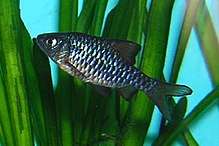Checker barb
The checker barb (Oliotius oligolepis)[1] is a species of cyprinid fish endemic to creeks, rivers, and lakes in Sumatra, Indonesia. It has also been established in the wild in Colombia. The adult males have red fins with black tips. It will grow up to a length of 5 centimetres (2.0 in) TL.[2] This species is the only known member of its genus.[1]
| Checker barb | |
|---|---|
 | |
| Checker barb in an aquarium | |
| Scientific classification | |
| Kingdom: | Animalia |
| Phylum: | Chordata |
| Class: | Actinopterygii |
| Order: | Cypriniformes |
| Family: | Cyprinidae |
| Subfamily: | Barbinae |
| Genus: | Oliotius Kottelat, 2013 |
| Species: | O. oligolepis |
| Binomial name | |
| Oliotius oligolepis (Bleeker, 1853) | |
| Synonyms | |
| |
Etymology
The genus name Oliotius is derived as a combination of a portion of the specific epithet oligolepis and its former genus name Puntius.[1]
The common name "checker barb" (as well as such related names as "checkered barb", "chequer barb" and "checkerboard barb") derives from the black marks on its side similar in appearance to those found on a checkerboard.
Taxonomic issue
This species has sometimes been placed in the genus Barbus though Barbus oligolepis Battalgil, 1941 properly refers to another fish species that is only found in Turkey. Since Bleeker's oligolepis is not placed in Barbus, both names are valid.[3]
Habitat
Checker barbs natively live in a tropical climate and prefer water with a pH of 6.0 - 6.5, a water hardness of 10.0 dGH, and a temperature range of 68–75 °F (20–24 °C). Their omnivorous diet consists of small worms, crustaceans, insects, and plants.
An egg-scattering fish, they spawn early in the morning on plants that are the center of the male's territory. Once the spawning is completed, the pair will attempt to eat the eggs that they can find.
In the aquarium
The checker barb has commercial importance in the aquarium trade industry; this peaceful fish is sometimes used in community tanks by fish keeping hobbyists. The checker barb is a schooling fish that is well suited to a community aquarium. It requires warm (75-77 °F), soft to medium-hard water. It occupies the medium to lower levels of the aquarium and is an omnivore, doing well on processed foods. The checker barb is a prolific egg-scatterer that lends itself well to the novice breeder.
External links
References
- Lambert, Derek J (1997). Freshwater Aquarium Fish. Edison, New Jersey: Chartwell Books. pp. 15. ISBN 0-7858-0867-1.
- Kottelat, M. (2013): The Fishes of the Inland Waters of Southeast Asia: A Catalogue and Core Bibliography of the Fishes Known to Occur in Freshwaters, Mangroves and Estuaries. Archived December 2, 2013, at the Wayback Machine The Raffles Bulletin of Zoology, 2013, Supplement No. 27: 1–663.
- Froese, Rainer and Pauly, Daniel, eds. (2013). "Oliotius oligolepis" in FishBase. October 2013 version.
- Barbus tauricus oligolepis Archived 2013-12-02 at the Wayback Machine, Catalog of Fishes, California Academy of Sciences